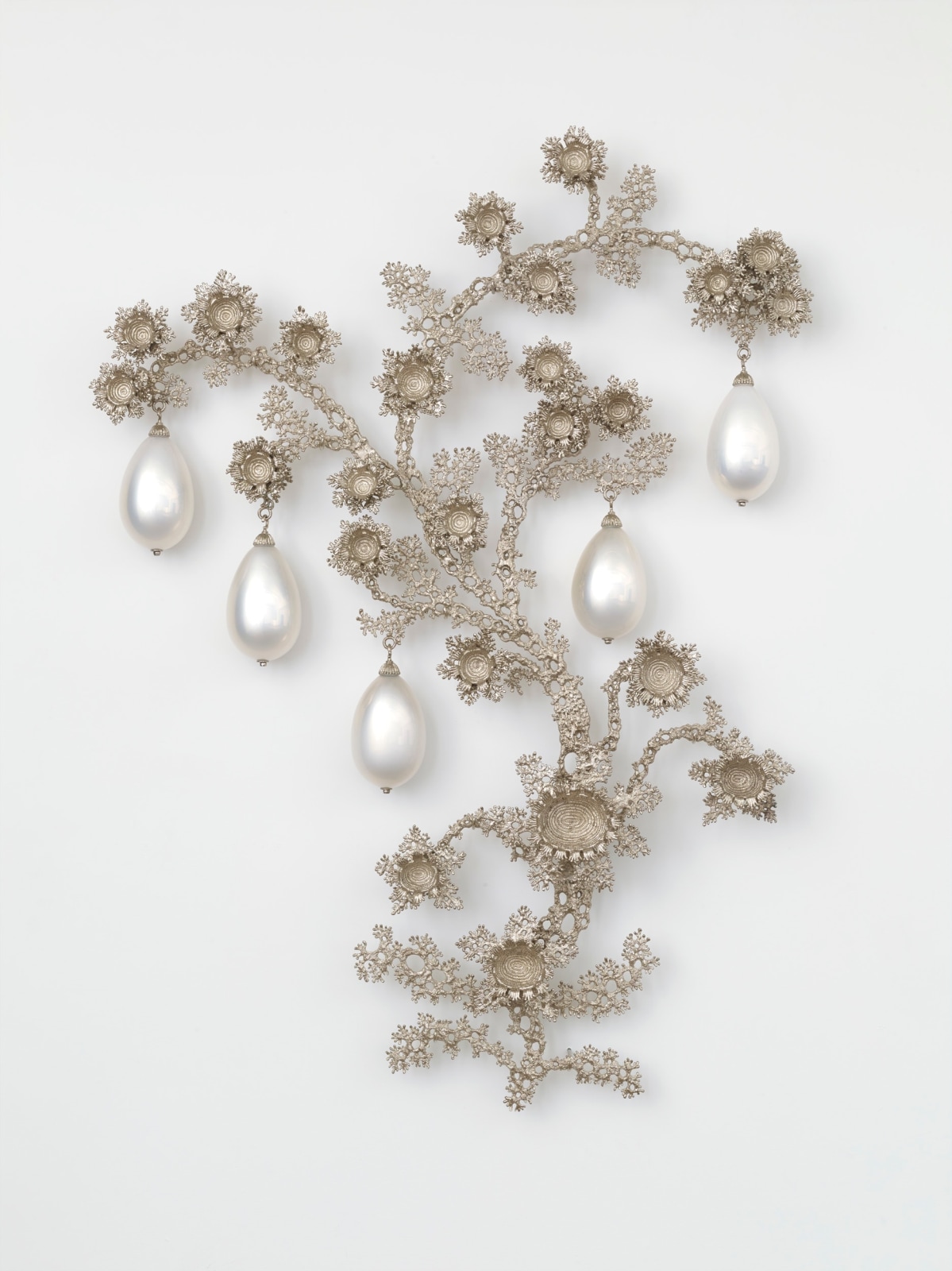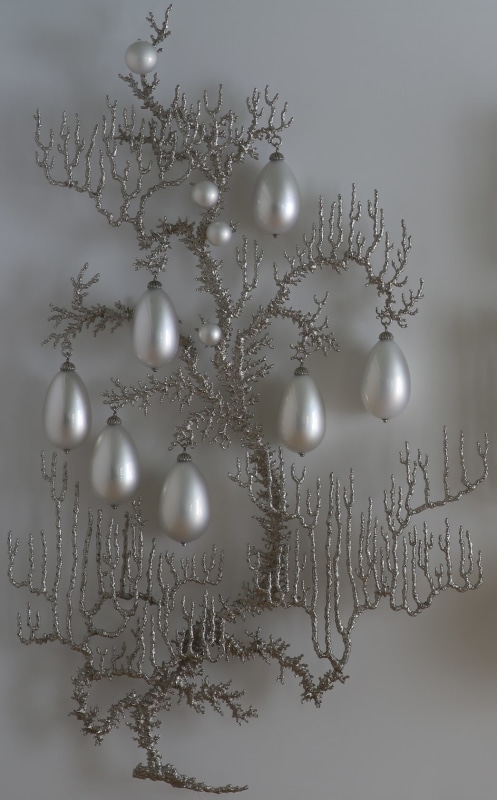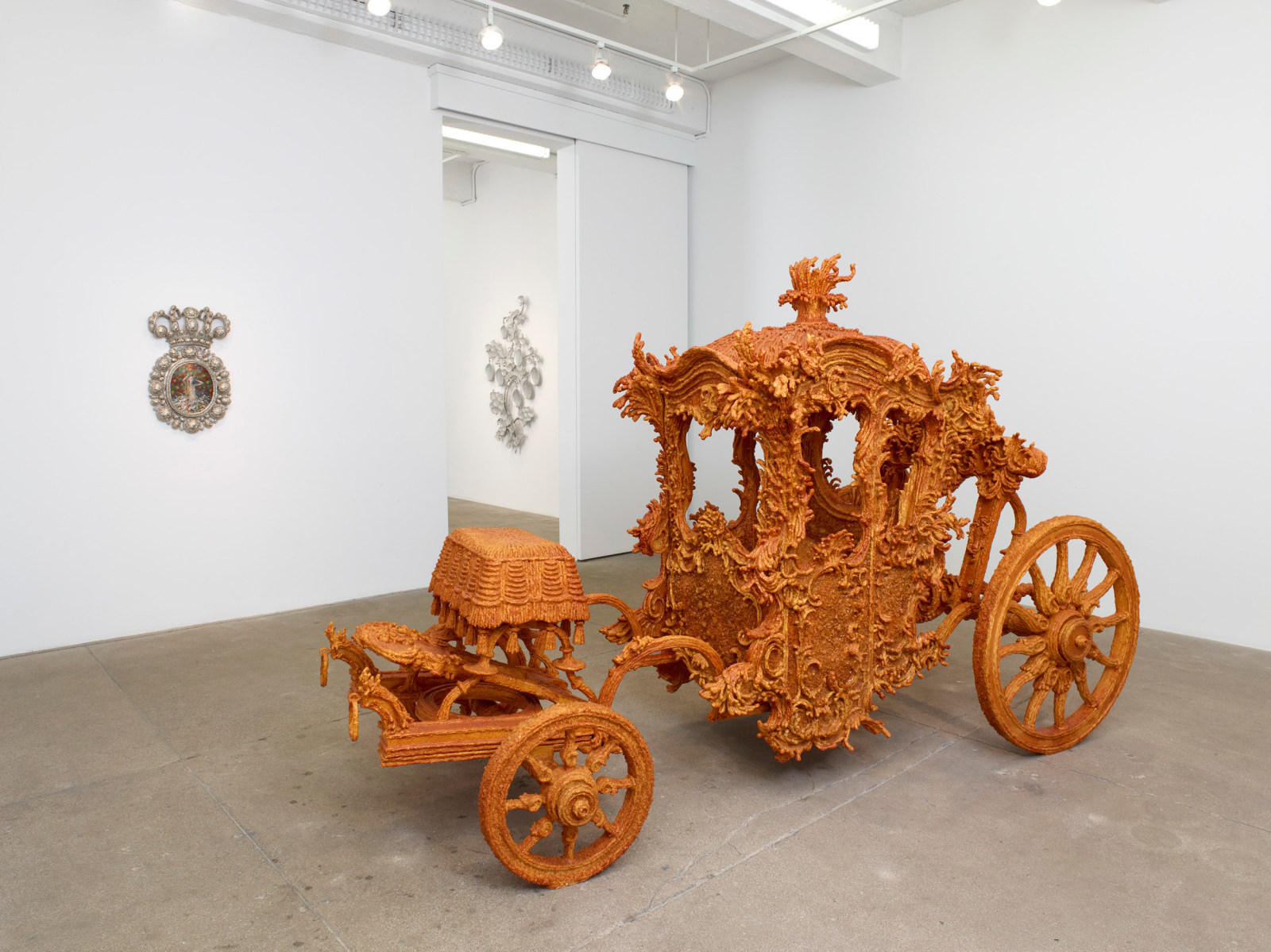
Timothy Horn
Tree of Heaven (lichen) IV, 2014
nickel-plated bronze, mirrored blown glass
80 x 60 x 8 ins.
203.2 x 152.4 x 20.32 cm
P·P·O·W is pleased to present Supernatural, a solo exhibition by Timothy Horn. Concerned with the intersection of the natural and constructed worlds, Horn has developed a practice that centers on borrowing forms found in nature to reinterpret decorative objects. This exhibit continues Horn’s investigation of inherent tensions between the organic and artificial, the miniscule and monumental, and the masculine and feminine. With this body of work, Horn turns his eye to the beauty found in nature and the ways in which we alter our environment.
The exhibition’s title refers to the original definition of supernatural: that which is not subject to the laws of physics, or exists above and beyond nature, which Horn sees as an apt description for how we navigate contemporary life – living beyond our means, at the expense of the natural world. Horn conceives of his exhibition as a 17th century wunderkabinett, a room filled with curiosities appropriated from nature, including authentic specimens, scientific phenomena, and fictitious mythological creatures. Supernatural offers a contemporary context for highlighting some of the challenges facing our world – a wunderkabinett for an environment under duress.
For the past decade, Horn has been inspired by two primary sources: 17th-century jewelry patterns by Gilles Legaré, court jeweler to Louis XIV, and 19th-century studies of organisms such as lichen, coral, and seaweed, found in zoologist Ernst Haeckel’s book Art Forms in Nature. Horn draws on the creative spirit and flair for embellishment of both Legaré and Haeckel to create a body of intricately crafted, sculptural works using blown glass, cast crystal, and various metals. Horn magnifies Baroque hair ornaments and earrings, replacing the ornate details and stonework with forms made to look like crenelated lichen and gorgonian coral fans.

Timothy Horn
Gorgonia 4 (Fukushima Fan Dance), 2015
nickel-plated bronze, mirrored blown glass
82 x 52 x 6 ins.
208.28 x 132.8 x 15.24 cm
Underpinning Horn’s primary theme of nature’s subjugation to human vanity are subtexts of gender identity. His 17th-century costume jewelry references allude to the pressures of homosexuals to “pass” in a straight world, in same the way that 17th-century French bourgeoisie were forced to pass as wealthy at the courts of Versailles. Baroque masculine power was displayed in embroidery, lace and jewelry. The natural curves of the human form were exaggerated to the supernatural.
Among the works on view will be Gorgonia 4 (Fukushima Fan Dance) and Gorgonia 6 (Bikini Atoll), large-scale recreations of jewelry patterns made out of nickel-plated bronze. Horn replaces the spine of the jewelry pattern with gorgonian coral forms, dripping with baroque pearls of mirrored blown glass. Both works refer to real-life events. Gorgonia 4 takes its title from the Fukushima disaster, where contaminated water poured into the Pacific Ocean. Horn highlights the precarious line we walk with our environment by simultaneously referencing the tradition of Japanese fan dance, a delicate and highly practiced routine. Gorgonia 6 refers to the island of Bikini Atoll where the U.S. performed nuclear tests. Horn conceives of this piece as a deity of the coral atoll, its branches radiating like shock waves. Also on view will be three Tree of Heaven works, composed of crenelated lichen forms. Lichen develop a symbiotic relationship with their host which makes them particularly sensitive to pollution and climate change. The title Tree of Heaven refers to the Chinese tree of the same name, known for its ability to thrive in difficult environments.

Horn will also exhibit Mother-Load (2008), a three-quarters scale recreation of a baroque carriage encrusted in crystallized rock sugar, originally created for his exhibition Bitter Suite at the de Young Museum in San Francisco. The work will be accompanied by Self Portrait as Peter the Great (2010), which Horn created in collaboration with painter Julie Heffernan, depicting a lone figure surrounded by what appears to be mass slaughter or extinction.
Timothy Horn was born in Melbourne, Australia. He studied Sculpture at the Victorian College of the Arts and Glass at the Australian National University. In 2002 he received a Samstag Scholarship and moved to the U.S., where he completed his graduate work at Massachusetts College of Art. Horn's work has been the subject of solo exhibitions at the de Young Museum, San Francisco, SJ ICA, San Jose, and Lux Art Institute, Encinitas. His work has also been featured in major group exhibitions at the Andy Warhol Museum, Pittsburgh, the Museum of Arts and Design, New York, GoMA, Brisbane, and the National Gallery of Australia, Canberra.
This project has been assisted by the Australian Government through the Australia Council, its arts funding and advisory body.